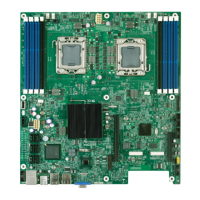Intel® Server Board S5500WB TPS Functional Architecture
Revision 1.3
Intel order number E53971-004
23
3.4.3 ECC Support
If at least one non-ECC DIMM is present in the system, the system reverts to non-ECC mode.
UDIMMs can be ECC or non-ECC; RDIMMs are always ECC enabled. Non-ECC DIMMs are not
validated and not recommended for server use.
3.4.4 Memory Reservation for Memory-mapped Functions
A region of size 40 MB of memory below 4 GB is always reserved for mapping chipset,
processor, and BIOS (flash) memory-mapped I/O regions. This region displays as a loss of
memory to the operating system. In addition to this loss, the BIOS creates another reserved
region for memory-mapped PCI Express* functions, including a standard 64 MB or 256 MB of
standard PCI Express* Memory Mapped I/O (MMIO) configuration space. This is based on the
setup selection using the MAX_BUS_NUMBER feature offered by Intel
®
Tylersburg IOH chipset
and a variably sized MMIO region for the PCI Express* functions.
All these reserved regions are reclaimed by the operating system if Physical Address Extension
(PAE) is turned on in the operating system.
3.4.5 High-Memory Reclaim
When 4 GB or more of physical memory is installed (physical memory is the memory installed
as DDR3 DIMMs), the reserved memory is lost. However, the Intel
®
5500 Series Chipset
provides a feature called high-memory reclaim, which allows the BIOS and operating system to
remap the lost physical memory into system memory above 4 GB (the system memory is the
memory that can be seen by the processor).
The BIOS will always enable high-memory reclaim if it discovers installed physical memory
equal to or greater than 4 GB. For the operating system, the reclaimed memory is recoverable
only when it supports and enables the PAE feature in the processor. Most operating systems
support this feature. For details, see the relevant operating system manuals.
3.4.6 Memory Population Rules
You should populate the memory slots of DDR3 channels furthest from the Intel
®
5500 series
processor first. Therefore, if A1 is empty, you cannot populate/use A2.
Figure 16. Memory Channel Population

